Innovation and Competitiveness in the Territorial Brand of the Algarve: A Comparative Analysis of Its Social Media Communication and Web Content
Abstract
1. Introduction
Geographical Context
- -
- O1: To analyse the presence and activity of the Algarve territorial brand on social media, assessing its effectiveness in engagement and reach.
- -
- O2: To examine the content of the official Visit Algarve website, identifying the strategies used to promote the territory’s innovation and competitiveness.
- -
- O3: To compare the communication strategies used on social media and the website, determining their coherence and effectiveness in building the Algarve territorial brand.
2. Theoretical Framework
2.1. Place Branding: An Updated Concept
2.2. Building the Territorial Brand Through Social Media
2.3. Place Branding and Stakeholders
3. Material and Methods
3.1. Social Media Metrics Analysis
- The quantitative analysis of activity and performance. The number of posts per platform was recorded, alongside the formats used (image, video, carousel, link, status), average engagement per post, and monthly content distribution. Individual post engagement levels were also analysed, with posts exceeding a 1% interaction rate highlighted as high-performance cases.
- Lexical and hashtag analysis. A frequency analysis was applied to the entire set of posts to identify the most frequently used words and recurring hashtags. These elements were also compared against their expected averages to detect linguistic patterns, positioning strategies, and communication structures potentially linked to the success of the posts.
3.2. Website Content Analysis
- General Cross-Cutting Categories: These categories were based on the aforementioned destination branding studies and were designed to assess the coherence of brand positioning.
| Category | Portuguese | English |
| Identity/Brand | marca, identidade, autenticidade | brand, identity, authenticity |
| Emotions and Experience | emoções, memórias, vivência | emotions, memories, experience |
| Welcome and Hospitality | acolhimento, hospitalidade | hospitality, welcome |
| Quality and Comfort | conforto, qualidade, serviços | comfort, quality, services |
| Accesibility | acessibilidade, mobilidade | accessibility, mobility |
- 2.
- Tourism-specific thematic categories and associated subcategories.
| Sun and Beach | praia, mar, sol, costa, litoral, férias, clima |
| Nature | paisagem, parque nartural, observação, fauna, flora, trilha, biodiversidade |
| Turismo Activo | caminhada, ciclismo, aventura, desporto, canoagem, vela, escalada, ar livre |
| Gastronomy | gastronomia, vinho, comida tradicional, sabor/es, prova de bichos, produto local, mercado |
| Culture | cultura, história, património, museu, tradição, arquitectura, evento/festival |
4. Results
4.1. Results of Content Analysis
4.2. Results of Social Media Metrics
- Engagement
- Hashtag and Lexical Analysis
- Hashtag Analysis
4.3. Synthesis of Results
5. Discussion
6. Conclusions
Author Contributions
Funding
Institutional Review Board Statement
Informed Consent Statement
Data Availability Statement
Acknowledgments
Conflicts of Interest
Appendix A
| Brouchures Analysed: |
| Algarve Rota dos Omiada |
| Algarve Desporto |
| Algarve Natureza |
| Algarve Ideias & Inspiraçoes |
| Algarve Criativo |
| Algarve Cultural |
| Cozinha do Algarve |
| Dieta Mediterránica |
| Rota da Costa Atlántica |
| Guía da Oferta Turística Acessível Algarve |
| Guía de percorsos pedestres do Algarve |
| Albufeira |
| Alcoutim |
| Aljezur |
| Castromarim |
| Algarve Guía de Praias |
| Faro |
| Lagoa |
| Loule |
| Monchique |
| Guía de observaçao de aves no Algarve |
| Olhao |
| Portimao |
| Sao Brás de Alportel |
| Silves |
| Tavira |
| Vila do Obispo |
| Vila Real de Santo António |
| Algarve. Guia do patrimonio cultural |
| Algarve. Rutas e caminos |
| Algarve. O segredo mais famoso da Europa. |
| Guia turismo de naturaleza do Algarve |
| Algarve Percursos Cicláveis |
| Monchique percursos pedestres |
| Algarve Percursos de Ciclismo de Estrada |
| Algarve e a dieta mediterránica |
| Vinos do Algarve |
References
- Almeida-García, F. (2012). Tourism policy in Spain and Portugal. Cuadernos de Turismo, 30, 9–34. [Google Scholar]
- Bocanegra Barbecho, L., Toscano, M., & Delgado Anés, L. (2017). Co-creation, participation and social networks for making history. Ciencia con y para la sociedad. Historia y Comunicación Social, 22(2), 325–346. [Google Scholar] [CrossRef]
- Buhalis, D., & Foerste, M. (2015). SoCoMo marketing for travel and tourism: Empowering co-creation of value. Journal of Destination Marketing & Management, 4(3), 151–161. [Google Scholar]
- Carcelén-García, S., & Díaz-Soloaga, P. (2022). The brand co-creation process through eWOM: User profile, attitude and behavior. Revista Mediterránea de Comunicación, 13(1), 267–280. [Google Scholar] [CrossRef]
- Choi, S., Lehto, X. Y., & Morrison, A. M. (2007). Destination image representation on the web: Content analysis of Macau travel-related websites. Tourism Management, 28(1), 118–129. [Google Scholar] [CrossRef]
- Costa, V., & Almeida, C. (2015). Low-cost carriers, local economy and tourism development at four Portuguese airports: A model of cost–benefit analysis. Journal of Spatial and Organizational Dynamics, 3(4), 245–261. [Google Scholar]
- Cristòfol, F. J., Zamarreño-Aramendia, G., & Cruz-Ruiz, E. (2024). Building and communicating territorial brand values: The case of Destination British Columbia. GeoJournal, 89, 150. [Google Scholar] [CrossRef]
- Dann, G. M. (1996). The language of tourism: A sociolinguistic perspective. CABI. [Google Scholar]
- De la Osada Saurí, D., Ribeiro de Almeida, C. R., & Pitarch-Garrido, M. D. P. (2023). Coastal tourism across the Iberian Peninsula: A comparative analysis between the Algarve region and the Valencian Community. In Geography: Changes, challenges and adaptation—Proceedings of the XVIII conference of the Spanish Association of Geography, Logroño, Spain, September 12–14, 2023 (pp. 1531–1541). Asociación Española de Geografía. [Google Scholar]
- De San Eugenio Vela, J. (2011). The transformation of territories into brands: Recognition and differentiation of spatial identities in postmodern times [Doctoral thesis, Universitat Pompeu Fabra]. Available online: http://hdl.handle.net/10230/12303 (accessed on 7 May 2025).
- De San Eugenio Vela, J. (2013). Conceptual and theoretical foundations for place branding. Boletín de la Asociación de Geógrafos Españoles, 62, 187–207. Available online: https://bage.age-geografia.es/ojs/index.php/bage/article/view/1575 (accessed on 23 November 2024).
- De San Eugenio Vela, J., & Ginesta, X. (2023). Place branding in the face of new societal challenges. El Profesional de la Información, 32(3), e320311. [Google Scholar] [CrossRef]
- Eshuis, J., & Edwards, A. (2013). Branding the city: The democratic legitimacy of a new mode of governance. Urban Studies, 50(5), 1066–1082. [Google Scholar] [CrossRef]
- Gascó González, M. (2022). The impact of social media on the tourism sector from the tourist’s perspective [Undergraduate thesis, University of Alicante]. Institutional Repository of the University of Alicante. Available online: https://rua.ua.es/dspace/bitstream/10045/124019/1/TFG-Maria-Gasco-Gonzalez.pdf (accessed on 23 November 2024).
- Ginesta, X., Cristòfol, F. J., de San Eugenio-Vela, J., & Martínez-Navarro, J. (2024). The role of future generations in place branding: The case of Huelva city. Politics and Governance, 12(1), 123–134. [Google Scholar] [CrossRef]
- Govers, R., & Go, F. M. (2009). Tourism destination image formation. In Handbook of tourist behavior (pp. 53–67). Routledge. [Google Scholar]
- Hanna, S., & Rowley, J. (2015). Towards a model of the place brand web. Tourism Management, 48, 100–112. [Google Scholar] [CrossRef]
- Hays, S., Page, S. J., & Buhalis, D. (2013). Social media as a destination marketing tool: Its use by national tourism organisations. Current Issues in Tourism, 16(3), 211–239. [Google Scholar] [CrossRef]
- Iglesias-Sánchez, P. P., Correia, M. B., Jambrino-Maldonado, C., & de las Heras-Pedrosa, C. (2020). Instagram as a co-creation space for tourist destination image-building: Algarve and Costa del Sol case studies. Sustainability, 12(7), 2793. [Google Scholar] [CrossRef]
- Instituto Nacional de Estadística de Portugal (INE). (2025). Instituto Nacional de Estatística—Portugal. Available online: https://www.ine.pt/xportal/xmain?xpgid=ine_main&xpid=INE (accessed on 16 October 2024).
- Kavaratzis, M., & Ashworth, G. J. (2005). City branding: An effective assertion of identity or a transitory marketing trick? Tijdschrift voor Economische en Sociale Geografie, 96(5), 506–514. [Google Scholar] [CrossRef]
- Kavaratzis, M., & Hatch, M. J. (2013). The dynamics of place brands: An identity-based approach to place branding theory. Marketing Theory, 13(1), 69–86. [Google Scholar] [CrossRef]
- Kavaratzis, M., & Kalandides, A. (2015). Rethinking the place brand: The interactive formation of place brands and the role of participatory place branding. Environment and Planning A, 47(6), 1368–1382. [Google Scholar] [CrossRef]
- Leung, D., Law, R., van Hoof, H., & Buhalis, D. (2013). Social media in tourism and hospitality: A literature review. Journal of Travel & Tourism Marketing, 30(1–2), 3–22. [Google Scholar] [CrossRef]
- Méndez Prada, M. C., & López Barraza, L. M. (2020). Theoretical considerations for territorial brand building applied to tourism for local development. In Tourism and sustainable development: Reflections from Ibero-America (pp. 187–206). CECAR. Available online: https://libros.cecar.edu.co/index.php/CECAR/catalog/download/100/156/2383-1 (accessed on 21 October 2024).
- Morgan, N., Pritchard, A., & Pride, R. (Eds.). (2002). Destination branding: Creating a unique destination proposition. Butterworth-Heinemann. [Google Scholar]
- Muñiz, C., & Cervantes, M. (2010). Marketing de ciudades y “Place Branding”. Pecunia. Revista de la Facultad de Ciencias Económicas y Empresariales, 123–149. [Google Scholar] [CrossRef][Green Version]
- Nissan, E., Galindo, M.-A., & Méndez, M. T. (2011). Relationship between tourism and economic growth. The Service Industries Journal, 31(10), 1567–1572. [Google Scholar] [CrossRef]
- Pike, S., & Page, S. J. (2014). Destination Marketing Organizations and destination marketing: A narrative analysis of the literature. Tourism Management, 41, 202–227. [Google Scholar] [CrossRef]
- Reimao Costa, M., & Batista, D. (2012). The role of built rural heritage in the contemporary landscape of Central Algarve. In Recent researches in environmental science and landscaping (pp. 78–83). Universidade do Algarve. [Google Scholar]
- Valle, P. O. d., Guerreiro, M., Mendes, J., & Silva, J. A. (2011). The cultural offer as a tourist product in coastal destinations: The case of Algarve, Portugal. Tourism and Hospitality Research, 11(4), 233–247. [Google Scholar] [CrossRef]
- VisitAlgarve. (n.d.). Official tourism portal of the Algarve. Available online: https://www.visitalgarve.pt (accessed on 29 September 2024).
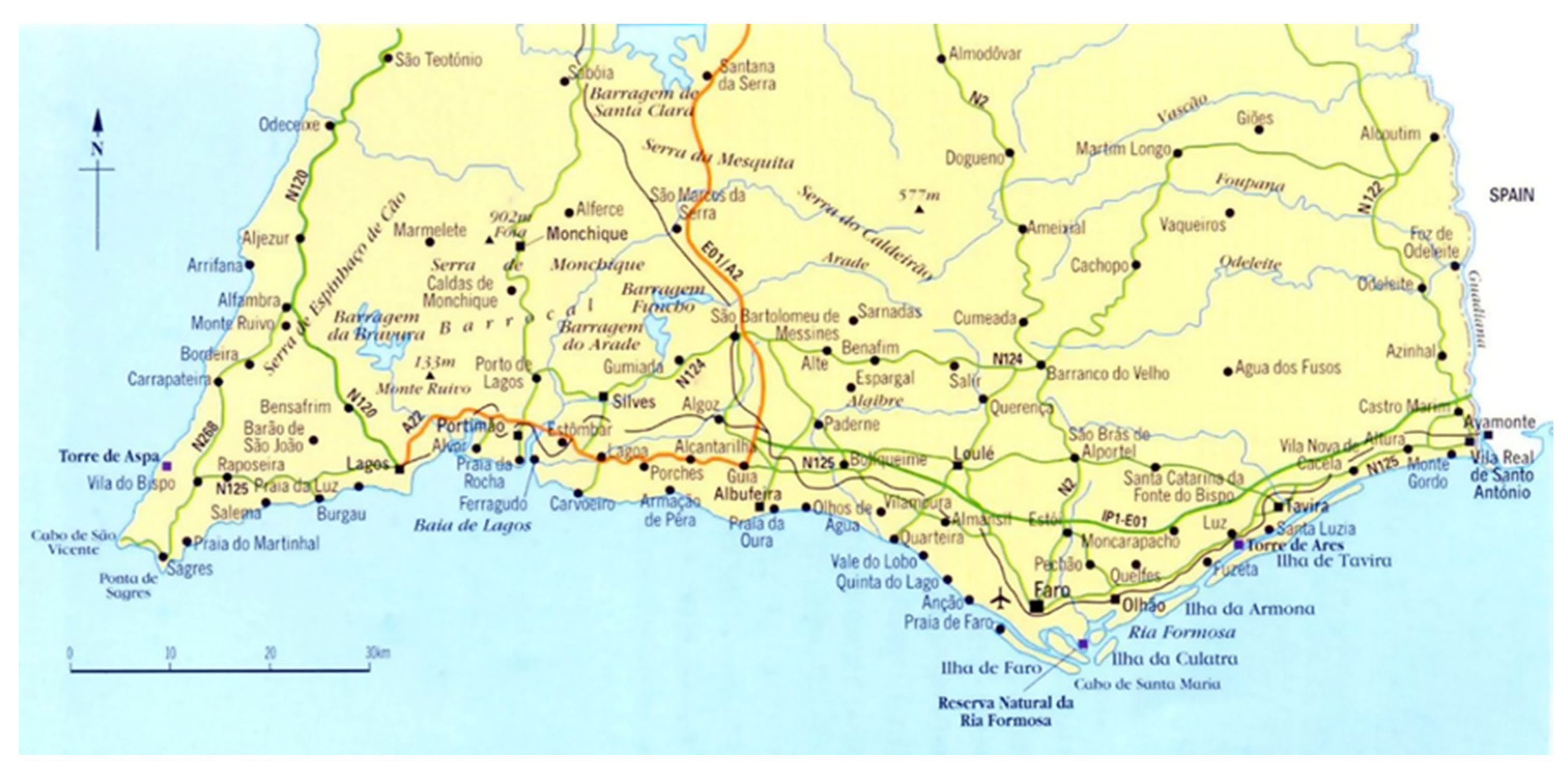

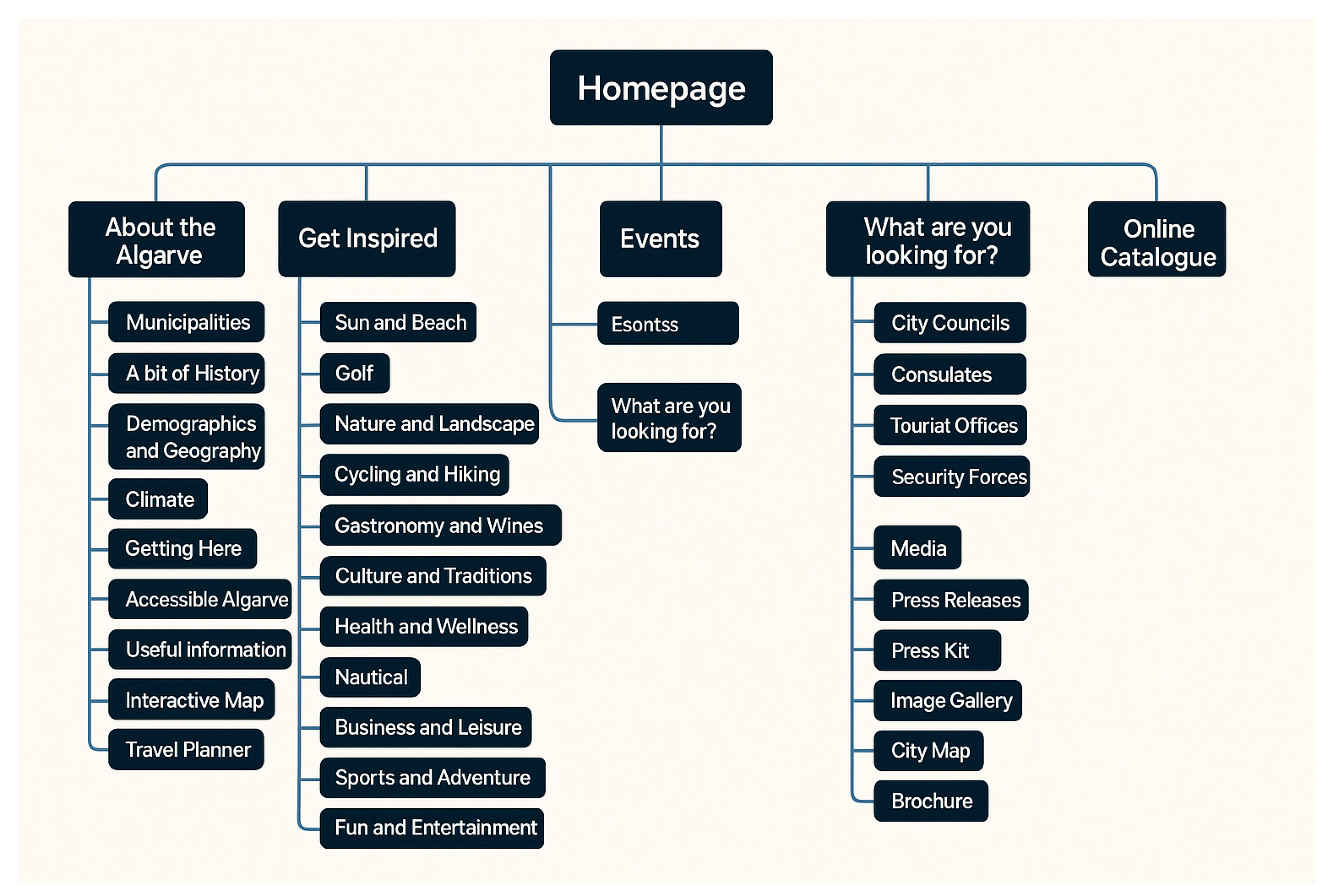
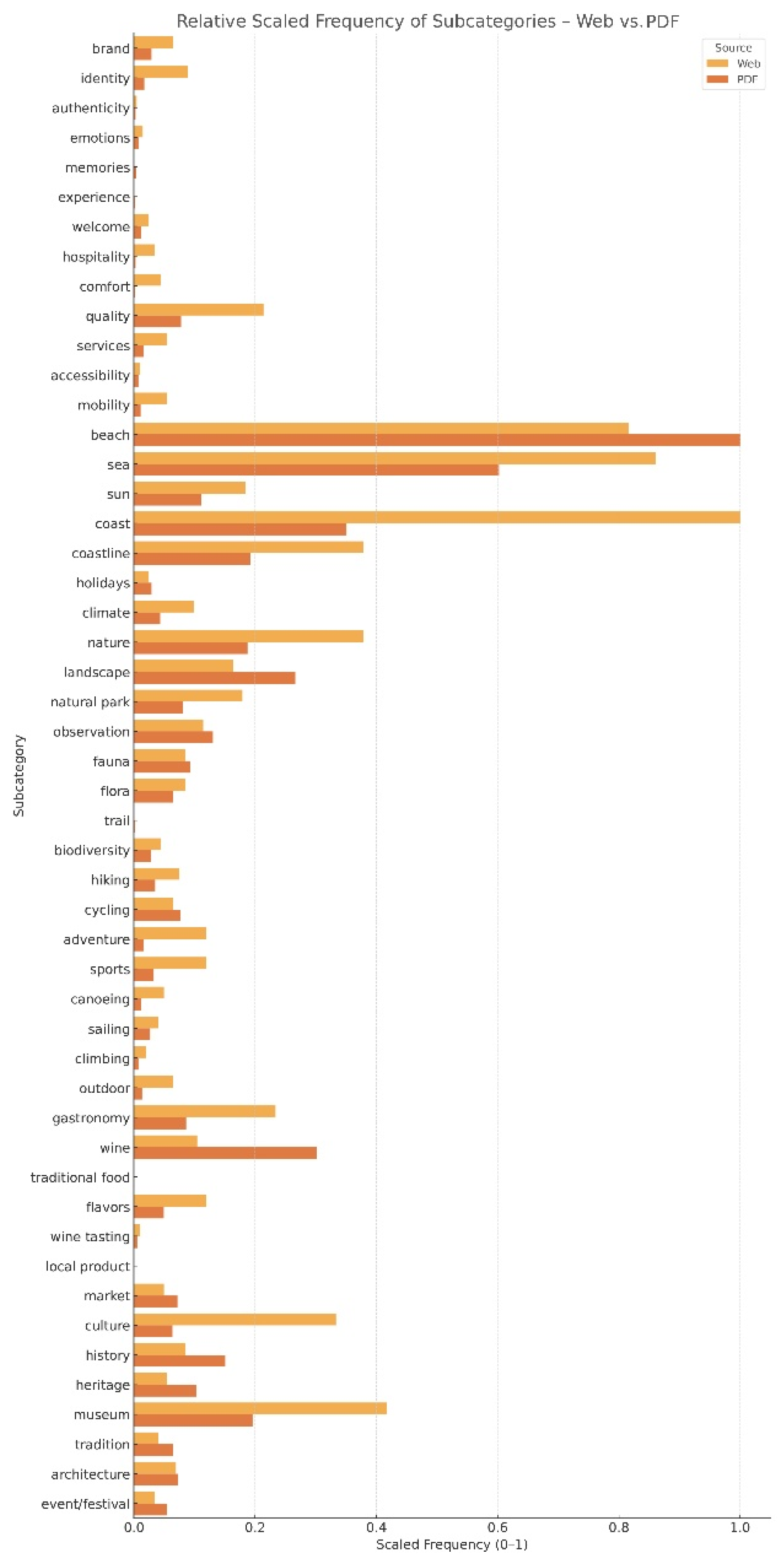
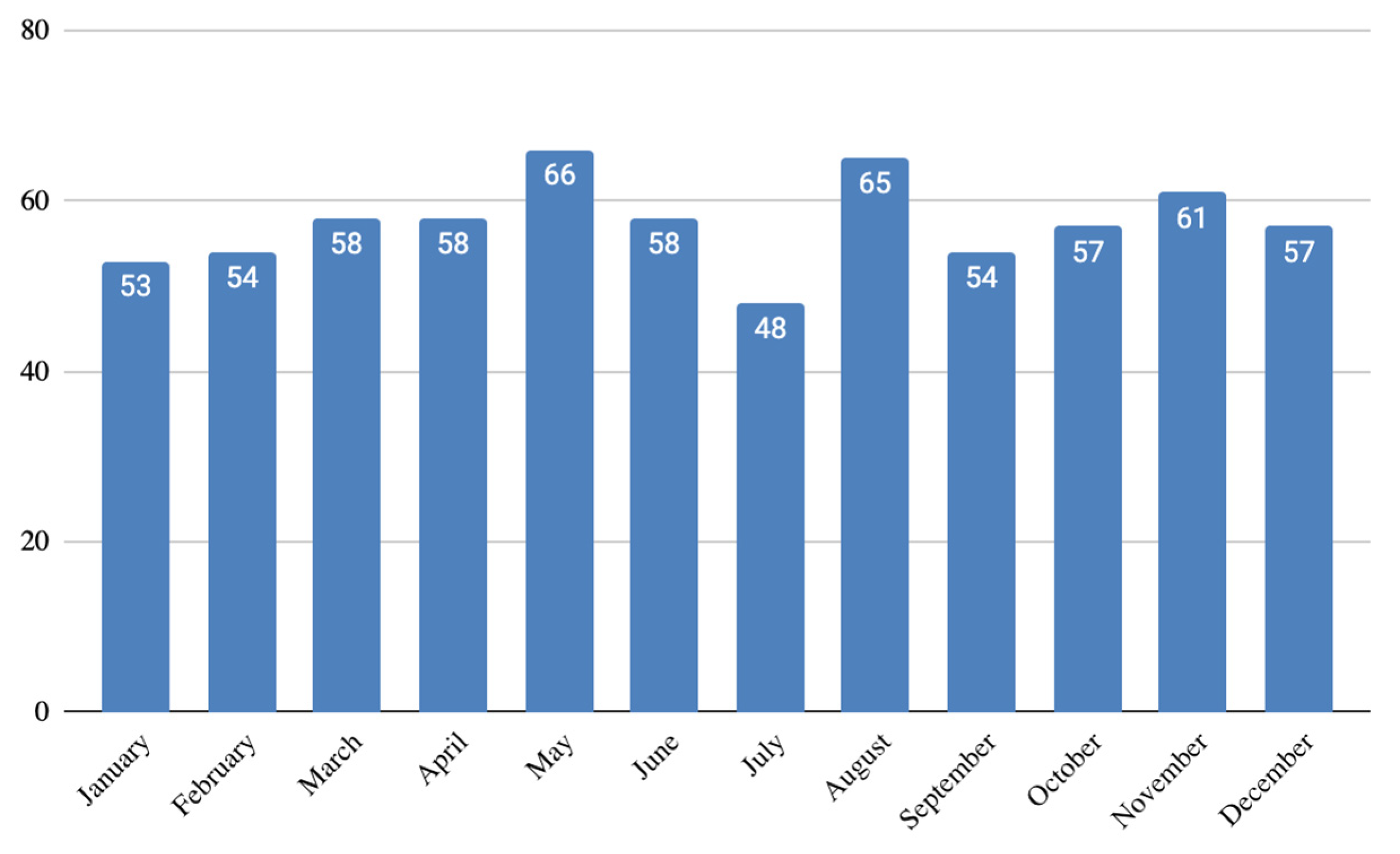
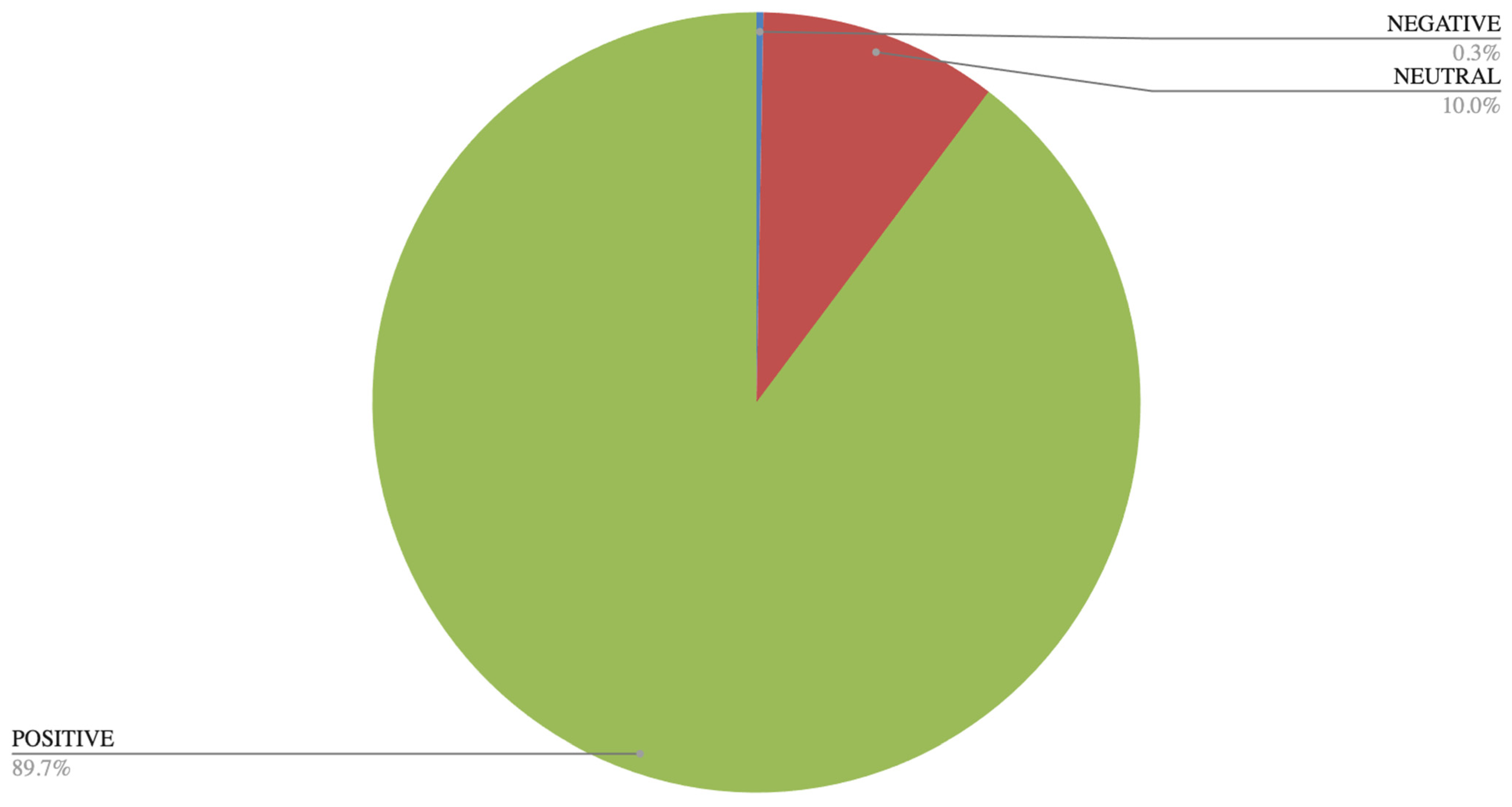
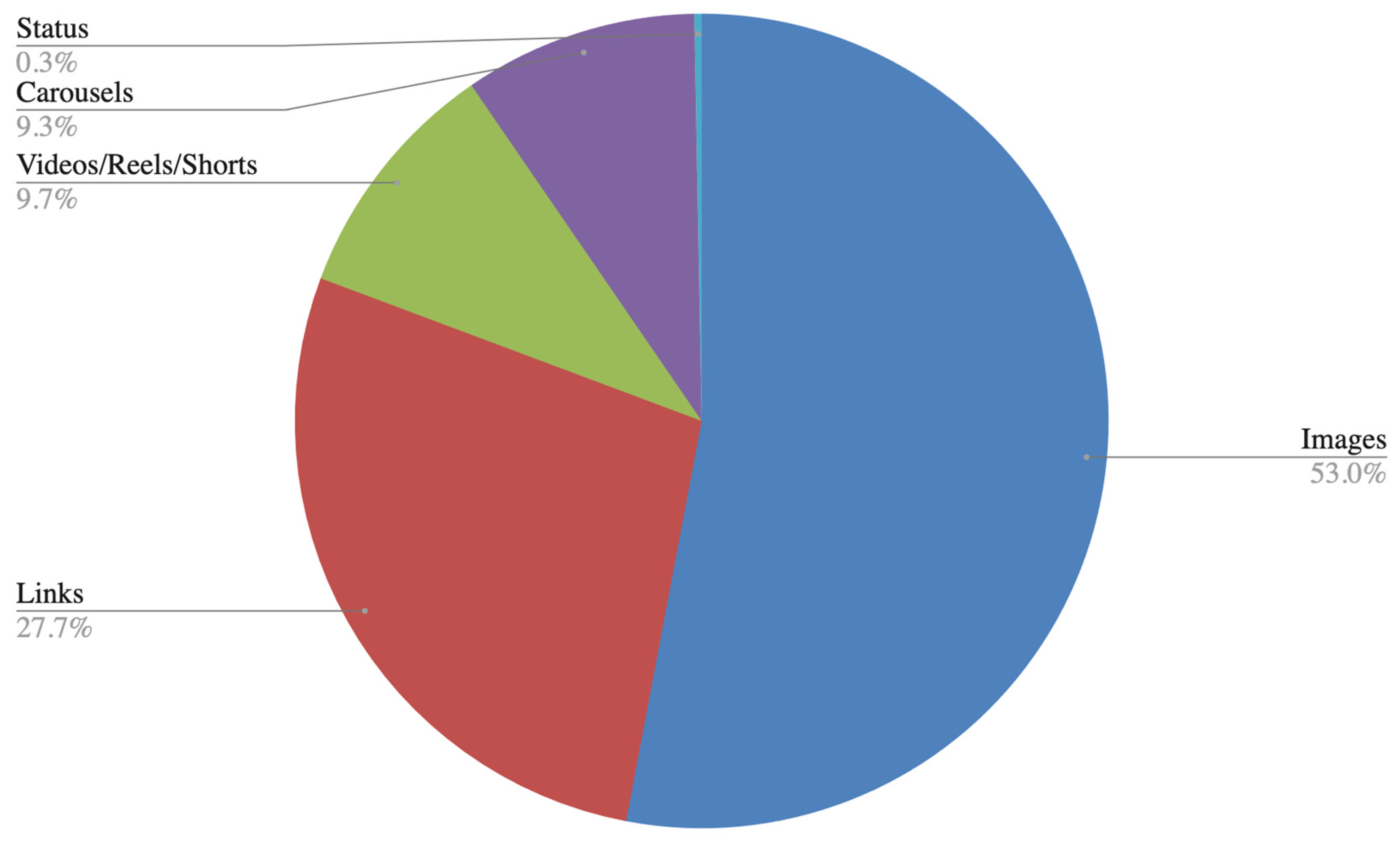
| Social Network | Iterations |
|---|---|
| 68.36 | |
| Youtube | 0.58 |
| 31.06 |
Disclaimer/Publisher’s Note: The statements, opinions and data contained in all publications are solely those of the individual author(s) and contributor(s) and not of MDPI and/or the editor(s). MDPI and/or the editor(s) disclaim responsibility for any injury to people or property resulting from any ideas, methods, instructions or products referred to in the content. |
© 2025 by the authors. Licensee MDPI, Basel, Switzerland. This article is an open access article distributed under the terms and conditions of the Creative Commons Attribution (CC BY) license (https://creativecommons.org/licenses/by/4.0/).
Share and Cite
Cristòfol, F.J.; Berraquero-Rodríguez, D.; Zamarreño-Aramendia, G.; Alves, P.F. Innovation and Competitiveness in the Territorial Brand of the Algarve: A Comparative Analysis of Its Social Media Communication and Web Content. Tour. Hosp. 2025, 6, 88. https://doi.org/10.3390/tourhosp6020088
Cristòfol FJ, Berraquero-Rodríguez D, Zamarreño-Aramendia G, Alves PF. Innovation and Competitiveness in the Territorial Brand of the Algarve: A Comparative Analysis of Its Social Media Communication and Web Content. Tourism and Hospitality. 2025; 6(2):88. https://doi.org/10.3390/tourhosp6020088
Chicago/Turabian StyleCristòfol, Francisco J., Diego Berraquero-Rodríguez, Gorka Zamarreño-Aramendia, and Paulo Falcão Alves. 2025. "Innovation and Competitiveness in the Territorial Brand of the Algarve: A Comparative Analysis of Its Social Media Communication and Web Content" Tourism and Hospitality 6, no. 2: 88. https://doi.org/10.3390/tourhosp6020088
APA StyleCristòfol, F. J., Berraquero-Rodríguez, D., Zamarreño-Aramendia, G., & Alves, P. F. (2025). Innovation and Competitiveness in the Territorial Brand of the Algarve: A Comparative Analysis of Its Social Media Communication and Web Content. Tourism and Hospitality, 6(2), 88. https://doi.org/10.3390/tourhosp6020088










